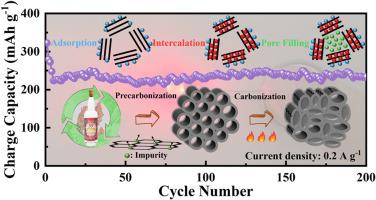Biomass-derived hard carbon from sorghum distilled residues as a high-performance anode for sodium-ion batteries
IF 11.6
2区 材料科学
Q1 CHEMISTRY, PHYSICAL
引用次数: 0
Abstract
In this study, hard carbon derived from sorghum distilled residues (SDR), synthesized at different sintering temperature, was firstly demonstrated as anode materials for Na ion batteries. We focused on crystal structure, chemical composition, surface morphologies as well as electrochemical performance and Na+ storage mechanism of as-synthesized hard carbon. With sintering temperature increased, these samples exhibited a higher degree of graphitization and fewer defects, leading to significant improvements in the initial coulombic efficiency (ICE) and reversible capacity. The sample sintered at 1400 °C (SDR14) showed a high reversible capacity of 295 mAh g−1 at a current density of 0.1 A g−1 with an ICE of 84.3 %. The superior performance of SDR14 was attributed to the synergistic effects of moderate graphitization, suitable interlayer spacing, closed-pore structures, and optimized pore distribution, which collectively enhanced Na + intercalation and extended the plateau capacity. Galvanostatic intermittent titration technique (GITT) tests revealed that sintering temperature significantly influenced Na + storage behavior. The in-situ XRD measurements further confirmed the structural stability of SDR14 during charge and discharge processes. Condition-optimized SDR14 electrode exhibited a long cycle life up to 200 cycles at 0.2 A g−1, and Na3V2(PO4)3|SDR14 full-cells demonstrated superior rate performance and high energy density of 197.7 Wh/(kg of active material only) at a power density of 21.1 W/kg, showing its great potential as a high-performance anode material for Na ion batteries.

从高粱蒸馏渣中提取的生物质硬碳作为钠离子电池的高性能阳极
本研究首次以高粱蒸馏渣(SDR)为原料,在不同烧结温度下合成了硬碳,作为钠离子电池的负极材料。重点研究了合成硬碳的晶体结构、化学成分、表面形貌、电化学性能和Na+储存机理。随着烧结温度的升高,这些样品表现出更高的石墨化程度和更少的缺陷,从而显著提高了初始库仑效率(ICE)和可逆容量。在1400°C (SDR14)下烧结的样品在0.1 a g−1电流密度下具有295 mAh g−1的高可逆容量,ICE为84.3%。SDR14的优异性能是适度石墨化、适宜层间距、封闭孔隙结构和优化孔隙分布的协同作用,共同增强了Na +的嵌入作用,扩大了平台容量。恒流间歇滴定技术(git)测试表明,烧结温度对Na +的储存行为有显著影响。现场XRD测试进一步证实了SDR14在充放电过程中的结构稳定性。条件优化后的SDR14电极在0.2 a g−1下的循环寿命长达200次,Na3V2(PO4)3|SDR14全电池在21.1 W/kg的功率密度下表现出优异的倍率性能和197.7 Wh/ kg(仅活性材料)的高能量密度,显示出其作为高性能钠离子电池负极材料的巨大潜力。
本文章由计算机程序翻译,如有差异,请以英文原文为准。
求助全文
约1分钟内获得全文
求助全文
来源期刊

Carbon
工程技术-材料科学:综合
CiteScore
20.80
自引率
7.30%
发文量
0
审稿时长
23 days
期刊介绍:
The journal Carbon is an international multidisciplinary forum for communicating scientific advances in the field of carbon materials. It reports new findings related to the formation, structure, properties, behaviors, and technological applications of carbons. Carbons are a broad class of ordered or disordered solid phases composed primarily of elemental carbon, including but not limited to carbon black, carbon fibers and filaments, carbon nanotubes, diamond and diamond-like carbon, fullerenes, glassy carbon, graphite, graphene, graphene-oxide, porous carbons, pyrolytic carbon, and other sp2 and non-sp2 hybridized carbon systems. Carbon is the companion title to the open access journal Carbon Trends. Relevant application areas for carbon materials include biology and medicine, catalysis, electronic, optoelectronic, spintronic, high-frequency, and photonic devices, energy storage and conversion systems, environmental applications and water treatment, smart materials and systems, and structural and thermal applications.
 求助内容:
求助内容: 应助结果提醒方式:
应助结果提醒方式:


